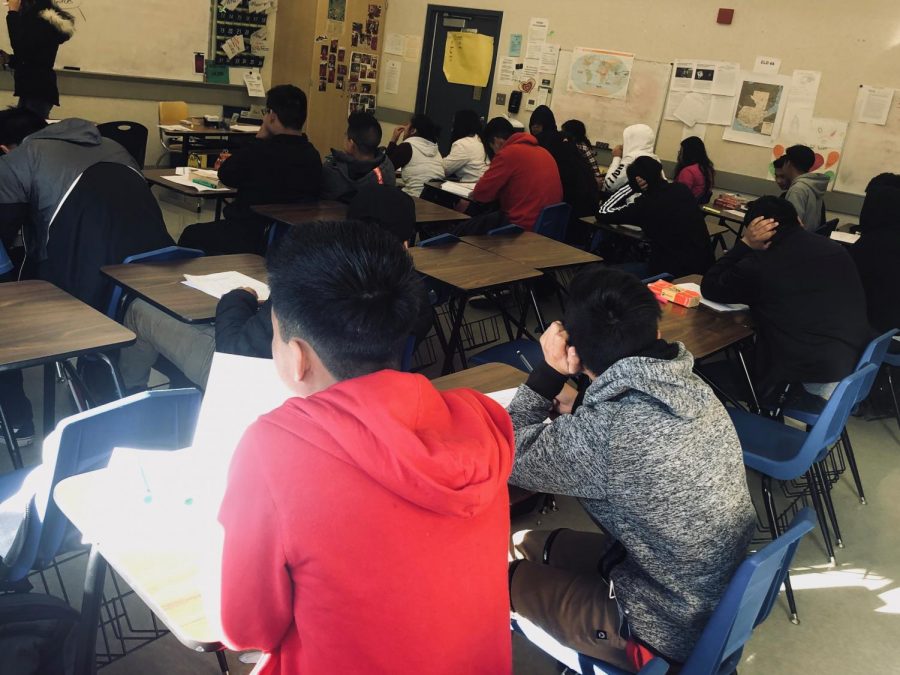Are ELD Students Being Set Up for Success or Failure?
January 25, 2019
My Spanish-speaking peer approaches me as I walk to my math classroom for help during advisory. With a concerned look on her face, Yoselin explains that she is worried about her grade in U.S. Government. She has a minimal understanding of the English language, but she acknowledges that a D in that class is not a good grade. In Spanish she says, “I don’t understand anything. I don’t know what the teacher says.”
Students with different levels of English comprehension make up the back rows of our U.S. Government and Physical Science classrooms. They frantically copy down the notes and huddle into a group when they take tests.
Counselors choose all of their classes based on their level of English comprehension.
“When students enter the U.S. and enroll in school here, our counselors ask the students their prior education level in their native country and their English level is assessed,” explains Ms. Boitano, “During the school year, the ELD teachers constantly reassess students and place them in their appropriate English levels.”
Still, counselors sometimes fail to secure them academic assistance when these classes are in English. These students rely on fellow bilingual classmates to help them with their academic work, along with teachers, who may speak little Spanish or none at all.
Students in higher level ELD classes find themselves seeking for help more often as they become integrated into college preparatory classes, which are taught in English.
ELD teacher Ms. Boitano acknowledges, “Intermediate and advanced students (ELD 3 and 4) come in for help with subjects like Biology, Physical Science, United States History, Government, and Economics. They usually need help understanding the material and understanding the task they are being assigned to do.”
These students are currently in an English Language Development (ELD) class depending on their ability to write, read, speak, and understand the language. The levels go from ELD 1 to English 9, English 9 being the most advanced level.
Ms. Boitano explains, “At San Rafael High, we offer 5 levels of ELD classes (ELD1- English 9 P SDAIE). Students are grouped by level of English and not by grade level. In each level, we work on their listening, verbal, reading, and writing skills.”
Being able to understand the topics in their classes is crucial because it determines their admission to college.
“In my experience, students who enter SRHS, with consistent schooling in their native country, tend to advance through the ELD levels faster than a student who has missed years of schooling,” recalls Ms. Boitano.
This is only a reality for a small percentage of these students.
“Most of the students I work with will have been in the country for 4 or 5 years at the most, and often only 2 or 3 years. It’s a relatively short amount of time to achieve college level fluency in any language, even if you’re immersed in the culture,” explains Mr. Nolan.
Siria Morales, a Spanish speaking student at SR admits that if she had a stronger understanding of the English language, she would have considered applying to a state school and not community college. “If I was able to speak English with fluency, I know I would be able to succeed in the classes needed for college.”
Most of these students settle for community college or the workforce, because except for English 9 SDAIE, ELD classes are not college preparatory classes. Students need to have college preparatory classes on their transcripts in order to be eligible for four year schools.
“COM is a great place where students can get the necessary skills and classes they need to enter four-year colleges/universities,” says Ms. Boitano.
Not only is being able understand the material a necessary challenge, but to succeed on a test is even more difficult. The tests themselves are sometimes hard to understand. “In Government we are put into a group and we take the test on the Chromebook. We can’t help each other though. We each have to take the test individually,” explains Yoselin.
We all sit among these students. Still, few students understand that most of the time they are intimidated by group projects and presentations that may seem like easy tasks for others.
All of these students have dreams and aspirations that can be limited by a short list of vocabulary words. Learning about our first amendment rights in our Government classes is valuable, but it could have an even more significant impact if every student could read them and understand what they mean.






































